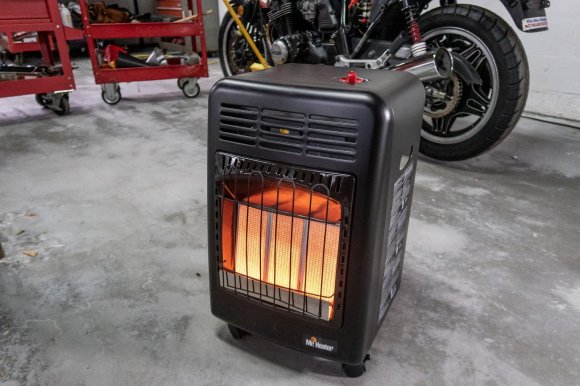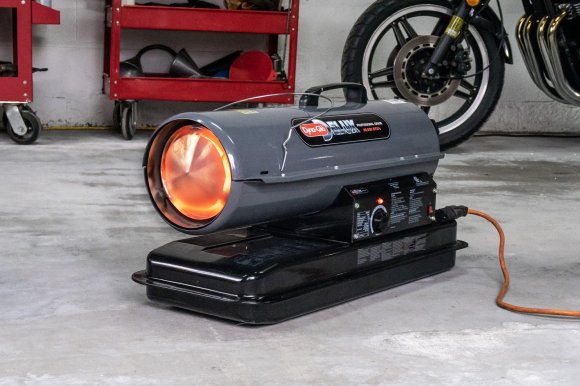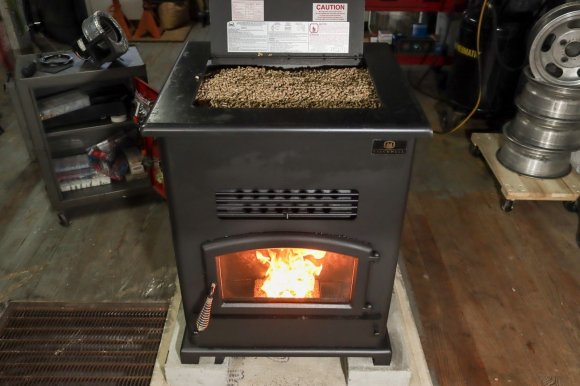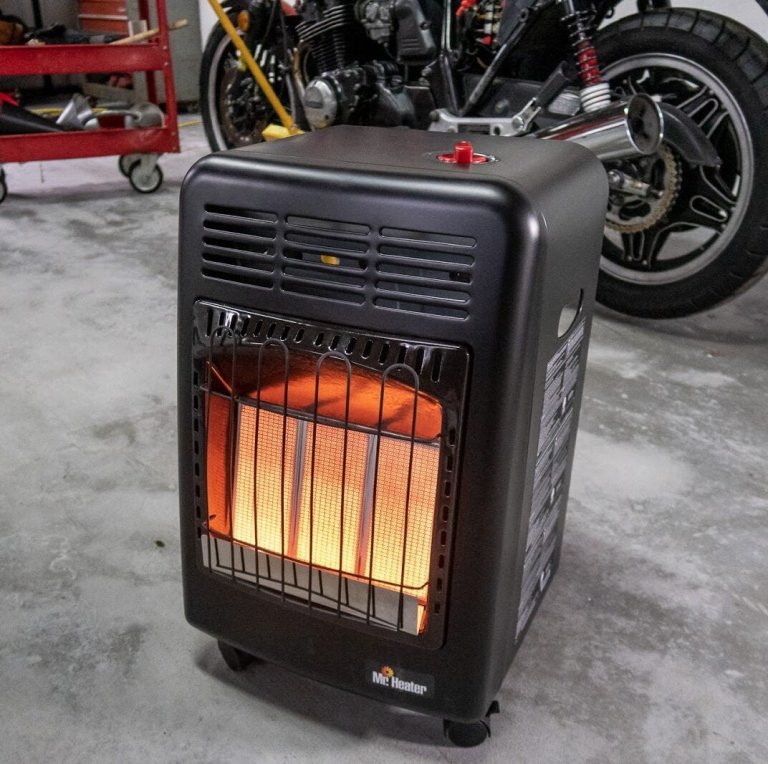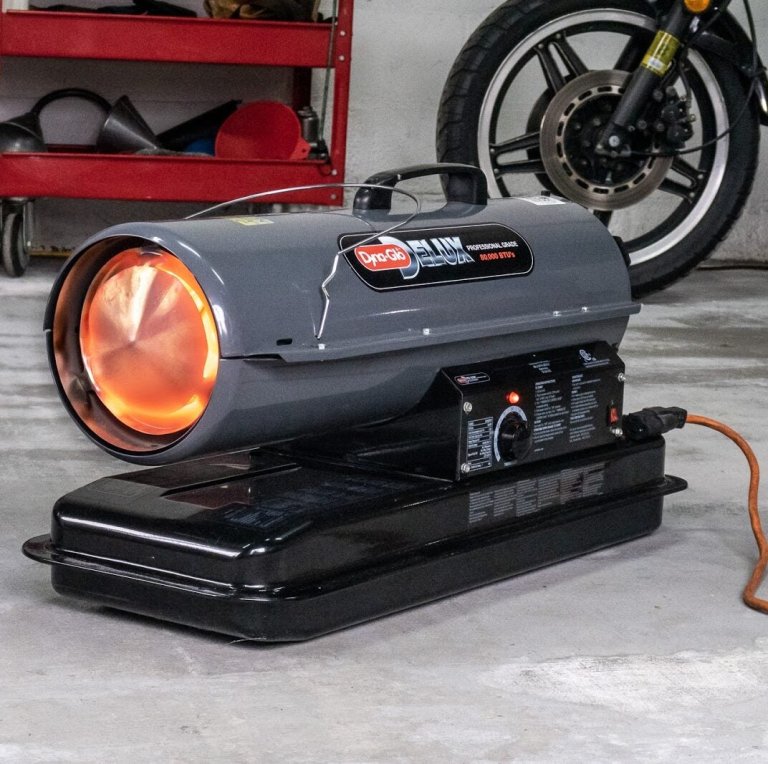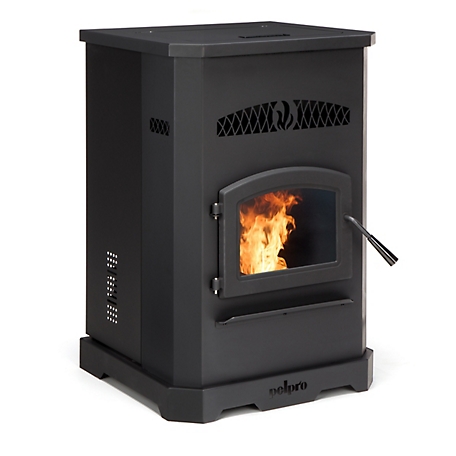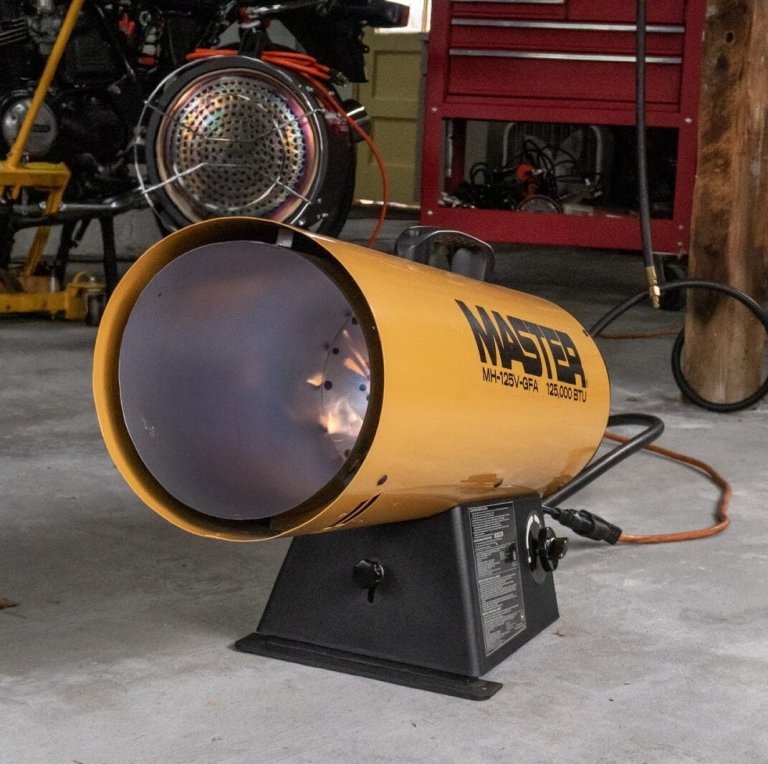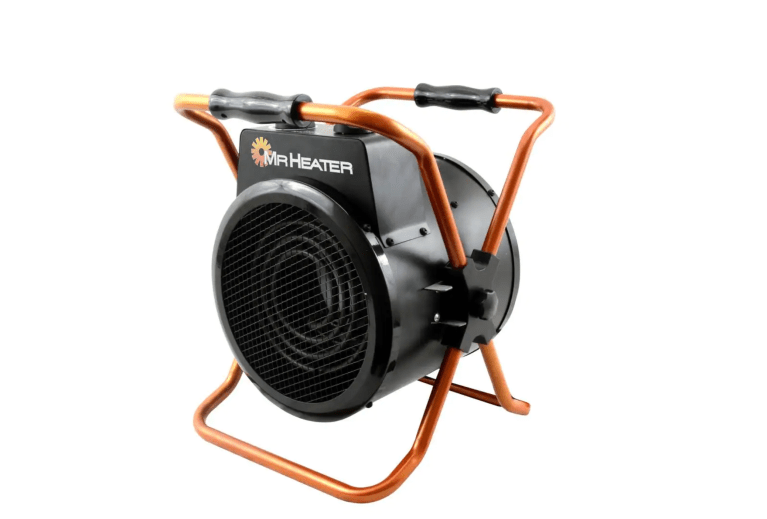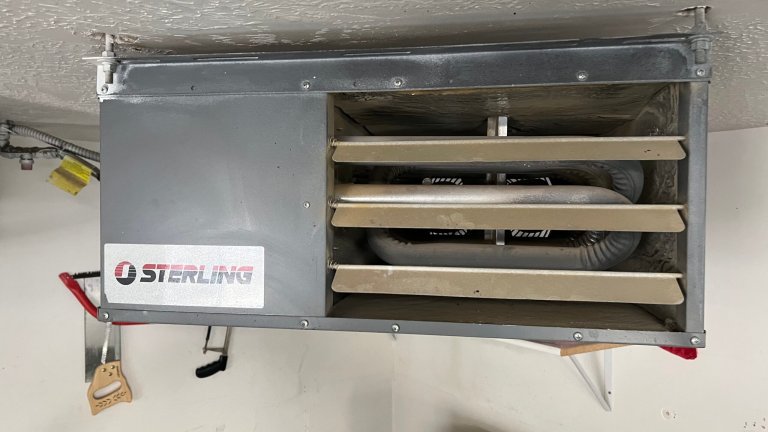We may earn revenue from the products available on this page and participate in affiliate programs. Learn more ›

Freezing temperatures and short days can put a damper on wrenching, but a garage heater can keep the project fire burning all year round. Finding the best garage heater starts and ends with the size of your garage and where you live. One gearhead’s insulated garage in Kentucky is another’s drafty old pole barn in the California Sierra Foothills. Each requires a different type and size heater to bring the temperature up to a comfortable level for year-round quality shop time.
Calculating how much heater you’ll need depends first on your garage’s size, type, insulation, and location. The next consideration is what type of fuel hits the trifecta of cost, availability, and efficiency.
What works in our Science Barn might not work for you, so we tested several space heaters in various configurations. Read on and find out which type of heater is the best for your garage and how we found a new favorite portable powerhouse.
Summary List
- Best Overall: Mr. Heater 18,000 BTU Cabinet Heater
- Best Value: Dyna-Glo Delux 80,000 BTU Forced Air Kerosene Heater
- Honorable Mention: Pelpro PP-130 Wood Pellet Heater
- Best Propane Torpedo: MASTER 125,000 BTU Propane Forced Air Torpedo Heater
- Best Heavy-Duty Electric: Mr. Heater Portable Forced Air Electric
- Best Ceiling-Mounted: Sterling GG45 Ceiling Heater
Our Methodology
New Englanders don’t dare rely on a single heat source in the home or the garage. Two heat sources and a backup is a good plan. We’ve tried more than a few heaters over the years, and this review features a mix of long-used and recently acquired garage heaters in a variety of types and fuel sources. Mr. Heater bestowed us with Ambassador status and sent a few test units for evaluation. Even though electric resistance heat is not cost-effective, we picked up a few smaller 1.5kw electric heaters for comparison.
Two things that you should have in any garage, especially when you’re using a combustion-fueled garage heater, are a carbon monoxide and smoke detector and a full complement of fire extinguishers. That said, finding the best garage heater hinges on a reasonably accurate calculation of how many BTU (British Thermal Units) you’ll need to turn a cold garage into a warm garage. It’s easy to convert BTU into kilowatt-hours, cords of firewood, or cold fusion reactor output afterward.
Best Garage Heaters: Reviews & Recommendations
Best Overall: Mr. Heater 18,000 BTU Cabinet Heater
Pros
- No electricity required Rugged steel housing
- Built-in ignition and pilot light
- Uses standard 25-pound propane tank
- Nearly silent operation
Cons
- Wheels work best on smooth surfaces
- Combustion heaters produce carbon dioxide and carbon monoxide
Portability, power, and propane earned the Mr. Heater radiant cabinet heater our best overall garage heater choice. Despite FedEx’s best efforts, the heater arrived mostly intact.
The cabinet heater’s best feature is that it carries around a standard, 20-pound propane tank in its butt. Load up a tank, connect the regulator, fix the safety strap, and the heater is ready to roll. After a quick purge of the lines, we lit up the pilot with the built-in piezo ignitor and fired it up.
The wheeled wonder has three heat settings and throws out a good 6- to 8-foot swath of comforting radiant heat on high at about the same level of a four-log campfire. A standard 20-pound propane tank is good for 24 hours of 18,000 BTU output at maximum heat and 72 hours on the low 6000 BTU setting. Onboard low-oxygen and tip-over shut-off protection make for safer operation.
Mr. Heater Jr. runs clean and odor-free, nearly silent, and does not need electricity. Locking casters make it easy to roll and secure the heater anywhere in the garage for 450 square feet of sun-like infrared comfort.
Best Value: Dyna-Glo Delux 80,000 BTU Forced Air Kerosene Heater
Pros
- Rugged steel construction
- Can run on a variety of readily available fuels, from kerosene to jet fuel
- Can be moved where heat is needed
Cons
- Loud roar
- Can cause moisture issues
- Requires outside air for safe operation
This multi-fuel powerhouse has never let us down. The forced air torpedo was ready to run right out of the box, and the time-proven design is reliable, effective, and 98 percent efficient. Built for construction, auto shops, and professional garage applications, the Dyna-Glo Delux can run on K1 kerosene, diesel, heating oil, and even JP-8 jet fuel. Ultra-low sulfur K1 kerosene is recommended, and that’s what we poured into the tank.
Firing up 80,000 BTU of directional heating power is as easy as tanking up, plugging in, flipping a toggle switch, and turning the thermostat dial to the target temperature. A fuel gauge with the quantity remaining and run time scale indicates the 5-gallon tank is good for 9 hours. The run-time figure is optimistic, but the heater definitely lives up to its 1900 square feet rating. The thermostat automatically turns the heater off when it hits the temperature target and fires it back up to maintain comfort.
All steel construction, a flameout sensor, and an overheat auto shut-off valve make for safe operation. While the heater is for outdoor and indoor use, it needs fresh air for safety. The Dyna-Glo and other torpedo heaters are anything but quiet but deliver reliable point-and-heat power at an excellent price.
Honorable Mention: Pelpro PP-130 Wood Pellet Heater
Pros
- Renewable fuel source
- Convection heat from onboard blower fan
- Fully automatic starting and operation
- Can be used with a thermostat
Cons
- Expensive to purchase and operate
- Stovepipe not included
- Wood pellet fuel quality varies
- Long-term maintenance costs
Unlike a conventional wood-burning stove, the pellet stove is primarily a convection heater and requires electricity. An electric motor and auger feed pellets into the firebox, and an ignitor starts the fire. One more electric motor creates a draft, and another runs a room fan that blows heat into the air. When all these motors and augers and pellets and electronic sensors work together, wood pellet stoves crank out an impressive amount of heat.
Renewable fuel and high efficiency make a wood pellet stove an excellent option for home and garage use, but installation and maintenance costs can add up. In a perfect world, lumber and furniture industry byproducts like hardwood sawdust are compressed into wood pellets for heat from an otherwise wasted resource.
In reality, wood pellet fuel sources and quality vary wildly, and maintenance issues start once one or more electric motor bearings wear out, usually after a few years. Replacement motors can be expensive but relatively easy to remove and replace.
Best Propane Torpedo: MASTER 125,000 BTU Propane Forced Air Torpedo Heater
Pros
- Large tank
- 125,000 BTUs
- Very Hot
Cons
- Loud
- Fuel and electric cables
If propane and propane accessories are your thing, then the MASTER 125,000 BTU forced air heater is the answer to outdoor and semi-indoor heat in a hurry. The heat comes on strong and quick, and the built-in fan forces 400 cubic feet of air per minute for powerful convection.
Also known as a salamander, this propane torpedo heater features an automatic start, rotary heat dial, and comes complete with a hose and regulator. Most salamander heaters need a 120V power source, so plan on wrestling with a fuel supply hose and an electric extension cord when considering a propane torpedo.
Propane torpedoes or permanent installations are an excellent choice if you have a large supply tank for home heating — but keep in mind this unit requires a 100-pound tank for consistent operation. It’s not recommended for use with standard 20-pound barbecue tanks (and the heat wouldn’t last very long, anyway).
Any forced air torpedo makes a racket. While the fan and propane combustion combination is a little quieter than an oil burner, the continuous ignition makes the Master crackle like a giant spark plug. We shelved this unit as a backup, but not for a lack of heat. The snake pit of extension cords, air hoses, and gas lines was unwieldy.
Best Heavy-Duty Electric: Mr. Heater Portable Forced Air Electric
Pros
- Electric power
- Large enough for most garages
- Very portable
Cons
- Corded, which can get in the way
If you need an electric heater for a small garage or workshop, this is your best bet. With an all-steel housing and adjustable steel tube stand, the Mr. Heater portable forced air electric convection heater was the biggest and toughest of the bunch.
It was 33 degrees outside and 45 degrees on the porch when we turned on Mr. Heater. The larger barrel diameter and quiet low-speed fan make it seem like there’s not much heat flowing from the outlet, but it’s there all the same.
The all-steel bruiser brought the inside temperature up to 64 degrees in one hour and measured around 200 degrees at the outlet. Mr. Heater also makes a more powerful 3.6 kW version that runs on 240V.
Best Ceiling-Mounted: Sterling GG45 Ceiling Heater
Pros
- Out of the way
- Connects directly to your house gas
- Super hot
Cons
- Expensive
- Requires installation
Managing editor Jonathon Klein has been putting this heater to great use, as it came with his house. It’s the first time he’s had a heated garage and has used it throughout his cold and snowy Utah winters to do work on his old Volvo XC90, his current Honda Ridgeline, and his project Can-Am UTV. Along with a host of housework and projects.
This unit is quite stout and requires little maintenance, and puts out a ton of heat to heat the entirety of his two-car garage. If you want something that’ll be up off the floor and put out a ton of heat, you have to get a ceiling-mounted unit. That said, you’re gonna need someone to install it and that’s an extra cost.
Our Verdict
Choosing the absolute best garage heater depends on a reasonably accurate calculation of the required BTU, the ideal type of heater for your garage’s size and layout, fuel costs and availability, climate zone, and what’s in the budget. That said, our overall pick is the Mr. Heater 18,000 BTU Cabinet, as it’s a great solution for most folks.

Features to Know Before Buying a Garage Heater
Here’s everything you need to know.
How Many BTUs Does It Take to Heat My Garage?
For a rough estimate, figure on about 30-35 BTU per square foot for southern climates and 55-60 BTU per square foot for colder, northern regions. Using total cubic feet, desired garage temperature and insulation level together makes for a more accurate number. Start with volume. Bust out the tape measure and multiply your garage’s width by its length to figure its total square feet. Multiply that number by the highest point in the ceiling for total cubic feet.
Next up is figuring out your desired inside temperature vs. the outside temp. Warming a garage to 65 degrees from a winter freeze demands more BTU than just taking the chill out of a crisp spring morning.
Insulation is the last and most important factor. If your insulation won’t keep the heat inside or the cold out, you’re going to need more BTU. Rate your insulation from nonexistent (metal shed on a cement slab) to excellent (fully framed and insulated construction with raised floor) and factor that into your choice.
The Science Barn numbers worked out to 14,400 cubic feet, a temperature increase of 30 degrees (wishful thinking — ed.), and poor to nonexistent insulation. We plugged the numbers into six different online calculators and came up with wildly different BTU figures. We had estimates from over a million BTU (yikes!) to as low as 32,000. That’s why insulation, flooring, and ceiling height are so important.
All six online calculations averaged and rounded down worked out to about 460,000 BTU. So we’ll go with that for our garage heaters review but remember: There are a lot of online BTU estimators, but your needs will vary depending on the space you’re heating and where it’s located.
Types
Garage heaters use different fuels or configurations, but they fall into two types: convection and radiant. Convection heaters warm up the air; radiant heaters warm up surrounding objects. A steam radiator throws off a small amount of direct heat but primarily heats by convection. Radiant floor heating might warm up the garage floor a little — but it’s the convection that heats the surrounding air and keeps the room warm.
Convection heaters warm the air inside the building. Hot air rising from the heater creates a convection current that draws cold air through the bottom of the heater. Passive convection heaters may produce a little radiant heat, but the main advantage is quiet operation. Forced-air convection heaters speed up the process with a fan that draws in cold air in blasts out heat. Quick ramp-up and high BTU output make forced-air heaters a popular choice for shops and garages, but the combination of electric fans and combustion can sound like a J79 jet engine.
Radiant heaters may also be called infrared and are available in permanent and portable styles. Radiant heaters are great for larger garages because they throw heat at you without having to heat up 15,000 cubic feet of frigid air around you. Portable propane tank top, reflective electric, infrared, and kerosene radiant heaters can quickly move with you for instant warmth. Permanent wall-mount radiant heaters clear out floor space, and some come with blower fans for the best of both worlds. Hybrid units like our Mr. Heater kerosene-fueled radiant forced air heater take the combination approach.
Types of Garage Heater Fuel
Fuel cost and availability are essential factors in finding and running the best garage heater. We gathered up BTU figures for garage heater fuels from the United States Department of Energy and other sources, so use these for your calculations and run the numbers against your local fuel and utility rates for the total cost involved in warming up a cold garage. Wood BTU output will vary.
- One kilowatt-hour of electricity = 3,412 BTU
- One gallon of kerosene = 131,890 BTU
- One gallon of diesel fuel or home heating oil = 137,381 BTU
- One cubic foot of natural gas = 1,037 BTU
- One gallon propane = 91,452 BTU
- One pound of propane = 21,591 BTU
- One gallon of liquified natural gas = 82,000 BTU
- One pound liquified natural gas = 21,040 BTU
- One cord of firewood = 20,000,000 BTU
- One 40-pound bag of wood pellets = 320,000 BTU
Garage Heater Pricing
The price of a garage heater will depend on BTUs, features, and brand name. But a good price will be under $450.
FAQs on Garage Heaters
You’ve got questions. The Drive has answers.
If you have to ask, then “No” is the best and safest answer. If your garage is more barn or lean-to than garage, then maybe — but follow local fire codes and take every possible safety precaution. Any form of combustion creates carbon dioxide and carbon monoxide. Always install carbon monoxide, smoke detectors, and automotive-approved fire extinguishers before using any type of combustion garage heaters.
It depends on the garage heater. Some forced-air torpedo heaters have multi-fuel capability but may require adjustment and tuning for the best possible efficiency. Low-sulfur diesel fuel and heating oil are essentially the same, but K1 kerosene is best for wick heaters. Do not use K2, diesel, or heating oil in wick heaters.
It will definitely work a lot harder — but it probably won’t succeed. Uninsulated garages will require adding a lot more fuel to the fire. Factor insulation levels and building material R-values into your BTU calculations. Seal up as many drafts as you can and add more than a few BTU cushion to your temperature and cost calculations in colder climates.
